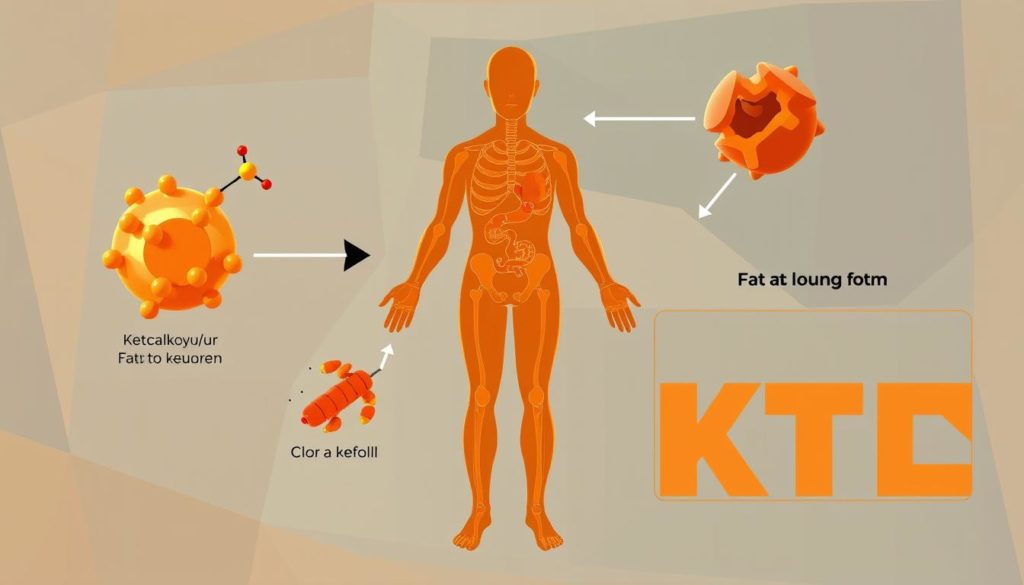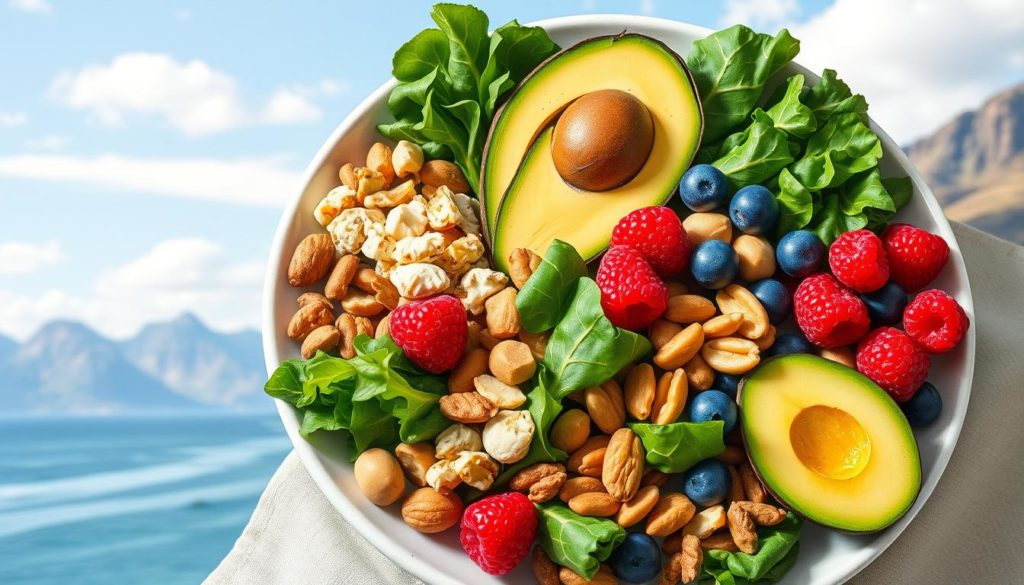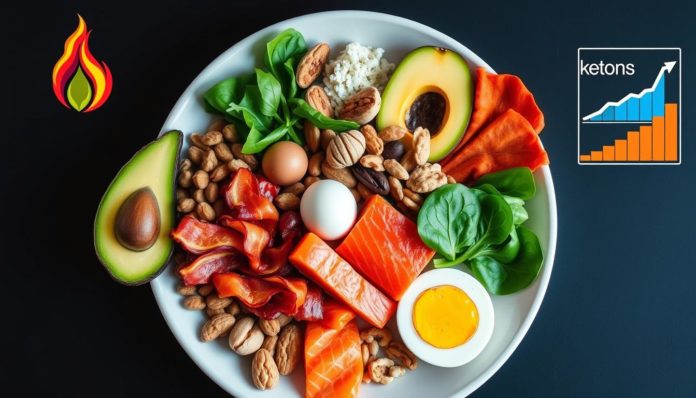Did you know over 20 million Americans have chosen a low-carb way of life? Many do it to enter ketosis and enjoy great health perks. Ketosis can help with weight loss, better control of blood sugar, and clearer thinking. This happens when you eat way fewer carbs, making your body burn fat for energy and create ketones.
People on a ketogenic diet cut down on carbs and eat more fat. They not only lose weight but also see their health get better. This diet can lower blood sugar and insulin. It might even help fight diseases like diabetes, cancer, epilepsy, and Alzheimer’s. Going keto is not just a trend, it’s a powerful way to improve your health.
Want to try ketosis and see these benefits for yourself? Start by eating 20 to 50 grams of carbs a day. Check out this guide to learn how to live a healthier, low-carb life with the help of ketosis.
What Is Ketosis?
Ketosis is a natural metabolic state when your body burns fats instead of carbs for energy. This happens when you eat far fewer carbs, leading your liver to produce ketones. These ketones then fuel your brain and body. Many people follow a ketogenic diet to reach this state because of its benefits.

| Aspect | Details |
|---|---|
| Ketosis Definition | A metabolic state where the body prioritizes fat as its main energy source, not carbs. |
| Trigger | Reduced carbohydrate intake. |
| Primary Energy Source | Fat and ketones. |
| Produced In | Liver. |
| Benefits | Weight loss, better mental clarity, and improved blood sugar levels. |
Ketosis is all about changing energy sources from glucose to fats. By adjusting your diet to include more fats, moderate protein, and very few carbs, you can enter ketosis. It’s not just about what you eat. It also involves changing your lifestyle.
How to Achieve Ketosis Naturally
Getting into ketosis naturally involves a few smart steps. We will look at three main ways that can help your body enter this state where it burns fat for energy.

Intermittent Fasting
Intermittent fasting is not just for losing weight. It’s also a great way to enter ketosis. By eating in a shortened time frame, your body uses up its glycogen quicker. Then, it starts using ketones for energy. This works even better when you eat fewer carbs.
Reducing Carbohydrate Intake
For ketosis, cutting down on carbs is key. If you limit your carb intake to less than 50 grams per day, your body turns to fat for fuel. This helps use up glucose stores and makes your liver make more ketones.
Increasing Healthy Fat Intake
Healthy fats are important in a ketogenic diet. Eating more good fats, like avocado, olive oil, and grass-fed butter, supports ketosis well. These fats give you steady energy. They also keep you feeling full longer, making your diet easier to follow.
| Method | Key Benefits |
|---|---|
| Intermittent Fasting | Faster depletion of glycogen stores |
| Reducing Carbohydrate Intake | Forces the body to use fat for energy |
| Increasing Healthy Fat Intake | Provides sustained energy and satiety |
Benefits of Ketosis
Exploring ketosis shows us how it helps with health improvements. It’s a metabolic state with many benefits.
Weight Loss
Ketosis is known for aiding weight loss. It switches the body to burn fat for energy. This makes losing weight easier without counting calories or feeling hungry.
Better Blood Sugar Control
Ketosis is great for managing diabetes. It helps with insulin sensitivity and controls blood sugar. This can lower the risk of type 2 diabetes.
Enhanced Mental Clarity
Many say ketosis boosts mental clarity and focus. Since the energy comes from ketones instead of glucose, brain function stays steady.
| Aspect | Benefits |
|---|---|
| Weight Loss | Efficient fat burning, reduced hunger |
| Blood Sugar Control | Improved insulin sensitivity, better blood sugar management |
| Mental Clarity | Enhanced focus, steady energy supply from ketones |
The Ketogenic Diet Explained
The ketogenic diet is known for being low in carbs and high in fats. It has become quite popular due to its health benefits. People can choose from several types, like the Standard Ketogenic Diet (SKD), Cyclical Ketogenic Diet (CKD), Targeted Ketogenic Diet (TKD), and the High Protein Ketogenic Diet. Knowing about these can help you pick the one that fits your health and fitness goals best.
Standard Ketogenic Diet (SKD)
The Standard Ketogenic Diet (SKD) is widely recognized and researched. It focuses on eating a lot of fats, a moderate amount of protein, and very few carbs. It’s aimed at getting your body into ketosis. In ketosis, your body uses fat for energy instead of carbs.
Cyclical Ketogenic Diet (CKD)
The Cyclical Ketogenic Diet (CKD) mixes higher carb days with the standard low-carb model. You would eat low-carb for five to six days, then have one or two days with more carbs. This method is great for keeping the benefits of ketosis. But it also allows carbs to support workout recovery and performance.
Targeted Ketogenic Diet (TKD)
The Targeted Ketogenic Diet (TKD) is perfect for those active in high-intensity workouts. It lets you eat carbs around the time you exercise. This gives you the energy boost needed for your workouts. Meanwhile, it helps keep the body in ketosis for other times.
High Protein Ketogenic Diet
If you need more protein, the High Protein Ketogenic Diet might be for you. It includes more protein and a bit less fat compared to the SKD. This plan is great for muscle building and keeping your protein intake high. It works well for those who find the standard keto plan too limiting or have greater protein needs.
| Type of Diet | Primary Features | Recommended For |
|---|---|---|
| Standard Ketogenic Diet (SKD) | High fat, moderate protein, very low carbs | Beginners, weight loss, ketosis promotion |
| Cyclical Ketogenic Diet (CKD) | Periods of higher carb intake | Athletes, muscle recovery, performance |
| Targeted Ketogenic Diet (TKD) | Carbs consumed around workouts | Active individuals, high-intensity workouts |
| High Protein Ketogenic Diet | Higher protein, lower fat | Bodybuilders, higher protein needs |
Keto Diet for Beginners
Starting keto is a big move towards your health goals. You mainly eat healthy fats and some protein, cutting down on carbs. Check out a beginner’s guide to keto to learn the basics if you’re new to this.
It’s important to know which foods to eat on keto. Let’s look at the essentials:
| Food Category | Examples |
|---|---|
| Meat | Beef, chicken, pork, lamb |
| Fatty Fish | Salmon, mackerel, sardines |
| Dairy | Butter, cream, cheese |
| Vegetables | Broccoli, cauliflower, spinach, kale |
| Nuts & Oils | Almonds, walnuts, olive oil, coconut oil |
Keeping track of your macros is essential. Knowing how much you need each day helps keep you in ketosis. Use apps like MyFitnessPal or Carb Manager for help. They track carbs, fats, and proteins for you.
Moderation is key with keto. Eating a variety of foods ensures you get all the nutrients you need. Remember, it’s a journey. Having good resources and support makes a big difference.
Success Stories with the Keto Diet
Many people have seen amazing ketogenic diet results. They’ve found more than just weight loss. Improved health and better blood sugar control are big wins, showing the real power of keto.
Some of the best stories come from those fighting type 2 diabetes. They’ve seen big health improvements. Some have even cut down or stopped their medications, thanks to stable blood sugar from keto.
Better focus and brain power are common praises in keto diet testimonials. People say they think clearer and concentrate better on keto. They credit these changes to eating low-carb and getting into ketosis.
“Switching to a ketogenic diet has been a game-changer for me. Not only have I lost weight, but my energy levels are through the roof, and my mind feels clearer than ever,” shared one enthusiast.
Keto has also helped folks with epilepsy and chronic inflammation. It’s more proof of the ketogenic diet results being diverse and positive.
- Substantial weight loss, often beyond initial goals
- Marked improvement in type 2 diabetes management
- Enhanced mental clarity and cognitive function
- Reduction in chronic inflammation and related conditions
These keto success stories inspire others to try this healthy, low-carb way of life. They show keto’s power to change lives.
Keto-Friendly Foods
Understanding what to eat on keto is key to keeping your body in ketosis. The keto diet includes foods that are high in fat but low in carbs. This helps your body stay in a state where it burns fat for energy.
Some main foods for keto are meat, fatty fish, and eggs. These foods are high in protein. They help you feel full and keep your muscles strong. Let’s look at some important foods for keto:
- Meats and Poultry: Beef, chicken, and pork are perfect. They are high in protein but don’t add carbs.
- Fish and Seafood: Fatty fish like salmon, mackerel, and sardines have lots of omega-3s. These are good for your heart.
- Dairy Products: Cheese, butter, and heavy cream are great for adding fats. They make meals more interesting.
- Non-Starchy Vegetables: Vegetables like spinach, kale, and broccoli add fiber and vitamins with few carbs.
- Avocados: Great for healthy fats and fiber. They help with digestion and overall health.
- Healthy Oils: Use coconut oil, olive oil, and avocado oil for cooking and salads.
- Nuts and Seeds: Almonds, walnuts, chia seeds, and flaxseeds are good for fats and protein, keeping carbs low.
Adding these foods to your diet helps you maintain the right balance of fats and carbs. If you’re just starting with keto or need more help, check out a detailed keto food list. It can really help.
Foods to Avoid on the Keto Diet
Starting a keto diet means knowing what foods to avoid. It’s crucial to steer clear of high-carb items to maintain ketogenic diet restrictions. Keeping away from these foods ensures you stay in ketosis and on track with your health goals.
- Grains and Starches: Pasta, rice, and bread are carb-rich and should be avoided.
- Sugary Foods: Avoid candies, sweets, and sugary drinks that can spike your insulin.
- Most Fruits: Except for some berries, fruits like bananas, apples, and oranges are too sugary.
- Beans and Legumes: They’re high in proteins but also carbs, so it’s best to skip them.
- Unhealthy Fats: Stay away from trans fats found in items like margarine or processed oils.
- Certain Condiments and Sauces: Avoid ketchup, BBQ sauce, and some dressings because they may have hidden sugars.
Here are details on foods to reduce or eliminate to keep in ketosis:
| Food Category | Specific Items to Avoid | Reason |
|---|---|---|
| Grains and Starches | Bread, Pasta, Rice | High in Carbohydrates |
| Sugary Foods | Candies, Sweetened Drinks | Cause Insulin Spikes |
| Fruits | Bananas, Apples, Oranges | High Natural Sugars |
| Beans and Legumes | Chickpeas, Lentils, Black Beans | High Carbohydrate Content |
| Unhealthy Fats | Margarine, Processed Oils | Contains Trans Fats |
| Condiments and Sauces | Ketchup, BBQ Sauce | Hidden Sugars |
Ketosis vs Ketoacidosis
It’s important to know the difference between ketosis and ketoacidosis, especially for those on a low-carb diet or with diabetes. While both lead to ketone production, their effects and causes are not the same.
Ketosis: Natural Metabolic State
Ketosis is when your body uses fat for fuel instead of carbs. It’s the aim for many on the ketogenic diet. This state brings health perks like weight loss and improved blood sugar levels. To reach ketosis safely, people use blood tests or keto strips for monitoring.
Ketoacidosis: Dangerous Condition
Ketoacidosis, however, is risky and could be deadly. It happens when there’s not enough insulin, causing too many ketones to form. This leads to acidic blood. It’s often found in those with type 1 diabetes and needs urgent care.
How to Differentiate the Two
To spot ketoacidosis, watch for symptoms like high sugar levels, a lot of urination, severe thirst, and confusion. These signs mean you should get help fast. Ketosis, though, is shown by feeling more energetic, less hungry, and generally better. Always talk to a healthcare provider about managing your body’s metabolic state correctly.
FAQ
What Is Ketosis?
Ketosis is a state where the body switches to burning fat for energy. It happens when you eat a lot fewer carbs. The liver turns fat into ketones, which the brain uses for fuel.
How Can I Achieve Ketosis Naturally?
To get into ketosis, try intermittent fasting and eat less than 50 grams of carbs a day. Include more healthy fats in your diet like avocado, olive oil, and grass-fed butter.
What Are the Benefits of Ketosis?
Ketosis can help you lose weight and control your blood sugar better. It also improves insulin sensitivity. You might notice your brain works better too, with more focus and quick thinking.
What Is a Ketogenic Diet?
The ketogenic diet is low in carbs and high in fats. It’s planned to make your body start ketosis. You’ll eat mainly fats, some protein, and very few carbs.
What Are the Different Types of Ketogenic Diets?
There are a few kinds of keto diets:
- Standard Ketogenic Diet (SKD): Lots of fat, some protein, and few carbs.
- Cyclical Ketogenic Diet (CKD): You eat more carbs at certain times.
- Targeted Ketogenic Diet (TKD): Eating carbs around the time you exercise.
- High Protein Ketogenic Diet: Similar to SKD but with more protein.
How Can Beginners Start a Keto Diet?
If you’re new to keto, learn how to swap carbs for fat and just enough protein. Keep track of what you eat each day. Focus on eating meat, fish, eggs, dairy, veggies that don’t have a lot of starch, and healthy oils.
Are There Any Success Stories with the Keto Diet?
Yes, many people have found great success with keto. They’ve lost a lot of weight, got their metabolism working better, and even improved their blood sugar levels. Some feel more alert and happy, thanks to their new way of eating.
What Foods Are Keto-Friendly?
You can eat meat, fatty fish, eggs, cheese, butter, cream, veggies that aren’t starchy, avocados, certain oils, and some nuts and seeds. These foods keep you in ketosis by fulfilling the diet’s need for fat and low carbs.
What Foods Should Be Avoided on a Keto Diet?
Stay away from grains, sugary foods, most fruits, beans, and certain sauces and fats that aren’t healthy. These foods can kick you out of ketosis, which messes up your diet goals.
What Is the Difference Between Ketosis and Ketoacidosis?
Ketosis is safe and comes from eating fewer carbs, while ketoacidosis is dangerous and happens in diabetes when ketones reach high levels. It’s important to understand the difference since ketoacidosis needs urgent care.


